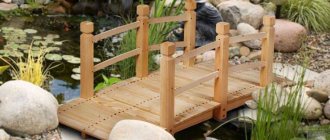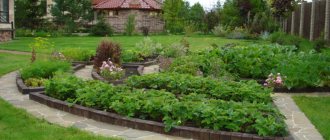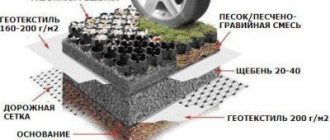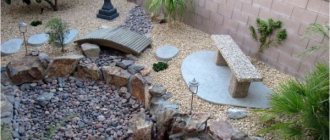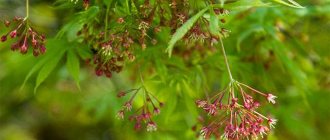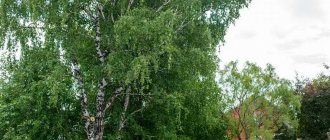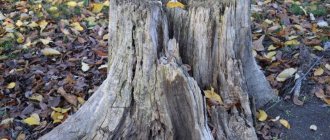Recently, standard trees planted in symmetrical compositions or in a zigzag pattern have become more and more popular in landscape design.
What is the essence of a plant of this form? How to make a standard tree with your own hands? What planting materials should I use? What are the secrets for growing and caring for them? Let's find out.
Description of the species
A standard tree is a plant with a long trunk, the top of which is decorated with a fluffy spherical crown or falling foliage. Such plantings look original and impressive.
Standard trees differ from each other in size and height. Typically their length varies from one hundred and fifty to two hundred and fifty centimeters.
In addition to an attractive aesthetic appearance, they have other advantages and disadvantages:
- save space;
- facilitate harvesting;
- promote comfortable service.
Which maple to plant on the plot
Several dozen species and varieties of maples are used in landscaping areas. To make a spectacular hedge, you can plant a low-growing maple tree on your site. In small areas, in rock gardens, mini-gardens, trees about 3 m high are planted. If the area is large enough, the owner chooses large trees with a height of 10 m or more.
The most popular types of maples:
Large sizes:
- Far Eastern
- Manchurian
- small-leaved
- Holly or Sycamore
- Silver
- Sugar
Shrubs or low growing trees:
- Bearded – up to 5 m
- Ginnala or Prirechny – up to 5 m
- Tatar – up to 7 m
- Ash-leaved – up to 7 m
- False Bolds – up to 8 m
Maples for the Japanese garden are low-growing, tiered, with an asymmetrical crown and horizontal branching of shoots:
- Fan or Palm-shaped
- Three-flowered
Snakebark species:
- Greenbark
Breeders divided almost every species into several varieties, differing in the color of foliage, shoots and bark, crown shape, and trunk height. After consulting with a landscape studio specialist, you can select and plant a maple tree in your dacha that will optimally suit it in size and shape.
Basic forms
How to grow a standard tree in your garden? This is not difficult to do. The main thing is to decide on the choice of form.
According to the appearance of the crown, standard plants are divided into:
Weeping trees include willow, rowan, elm, some types of apple trees, as well as creeping shrubs: climbing rose, juniper, cotoneaster.
In most cases, these plants are grafted artificially so that their branches fall down. This can occur vertically, in an arc, at an acute angle or umbrella.
The spherical forms include maples, acacias, larches, thujas and others.
There are several ways to form a standard tree - by grafting and by pruning. Let's talk about these two methods in more detail.
In the meantime, let's learn the general rules for planting a suitable seedling.
Before landing
Above, we determined which specific types of plants are best suited for standard trees and shrubs. Now let's find out how to choose the right seedling.
First and most importantly, the plant trunk must be straight and even. Remember: if knots and bends are found on the planting material, then during the growth process they will not go anywhere, which means the tree will lose its originality and attractiveness.
Moreover, when choosing seedlings, you need to pay attention to the healthy appearance of the bark and root system.
And one more thing - immediately after planting, the young tree needs support. Secure its trunk together with a wooden peg placed next to it.
Red maple
Red maple (Acer rubrum) is a tree that grows up to 15 - 20 m in height, with a massive, spreading crown. Even before the leaves appear, in March-April, whitish-red flowers bloom on the plant; flowering lasts 2 weeks. Then large three- to five-lobed leaves with a red tint appear on the tree, which gradually turn green by summer. In autumn, the top of the leaf blade is orange-red, and the bottom is pinkish-silver.
Growing conditions: red maple loves the sun, but is quite shade-tolerant. Wind, dust, smoke and gas resistant, can be grown in urban environments. It grows best on moist, sandy, sandy or loamy soils with a slightly acidic reaction and a high humus content. It is winter-hardy, tolerates waterlogging of the soil, but does not like alkalization and over-compaction.
Picturesque both in a group and as a tapeworm. In large areas, alleys are created from red maple.
Pay attention to these varieties:
- Columnare has a narrow pyramidal crown, its height is 15 - 18 m. In autumn, the leaves turn red-orange.
Method one: pruning
This method involves the gradual formation of a standard tree by trimming side shoots and branches. Although this process may take a long time, the final result will be simply amazing and will exceed all your expectations.
The first thing you will need to do is monitor the growth of side shoots, removing them in a timely manner. As soon as the planted tree reaches the required height (usually about one and a half to two meters), its top should be cut off. From this point on, the crown will need to be pinched using young shoots.
This procedure is labor-intensive and painstaking, since it is recommended to wait one month between each pinching. In addition, new ones will need to be added to the already pinched shoots.
However, do not be afraid of difficulties. The result is worth it.
How can you grow a standard tree with your own hands using grafting? This will be discussed below.
Method two: vaccination
The grafting (or transplantation) method is much more complicated than the pruning method, but the results of the manipulations will be visible within a few months. What is needed for this?
First of all, you need to take two seedlings, one of which will serve as a rootstock (or standard), and the second will act as a scion (from which the crown will be formed).
It is better to harvest scions in the fall. To do this, young shoots (one centimeter thick and up to half a meter long) are cut from the fruit tree, packaged in plastic film, wrapped in coniferous branches and buried. Such actions will help the cutting retain the necessary energy for establishment in a new place and subsequent development.
It is best to plant two identical crops. Sometimes related plants are used for this (for example, pear and rowan), due to which the trees begin to bear fruit faster.
Norway maple, or platanolea
Norway maple, or platanolea (Acer platanoides) is the most popular and recognizable type of maple; it was brought to Russia by Peter I. At first it was grown in the Summer Garden under careful care, since it was believed that it was not winter-hardy enough. Subsequently, it spread throughout the European part of the country, and currently the Norway maple shoots are disposed of as a weed.
This is a large massive tree growing up to 30 m in height with a dense crown. The leaves are five-lobed, up to 18 cm long. Their autumn color depends on how warm or cold, rainy or dry the past summer was. Color varies from yellow to orange, and can sometimes be purple. Very decorative are the small yellow flowers that appear on the plant in April-May, even before the leaves bloom. They pair beautifully with the black bark of the tree.
Growing conditions: Grows in any light. Wind, dust, smoke and gas resistant, suitable for living in the city. It grows best on moist, fertile loams with a high humus content and a slightly acidic or neutral reaction environment. Does not tolerate excessive moisture, acidity, overcompaction and high salinity of the soil. It is quite winter-hardy, but decorative forms can freeze and suffer from frost damage to the trunk. Norway maple tolerates pruning easily. Even mature trees (up to 10-15 years) can tolerate replanting.
Used in group and solo plantings. Compositions consisting of varieties with permanent purple leaf color and varieties that change their color from green to red and vice versa look interesting.
Pay attention to the following varieties:
- Globosum is a tree 4–7 m in height with a round or spherical crown, usually cultivated on a trunk. This is one of the most popular varieties.
The main points of grafting
What rules must be followed in order to grow a beautiful standard tree that is pleasing to the eye and harmoniously fits into the design? Here's a quick step-by-step guide:
- Grow the base (or standard). The young seedling is tied to a support and allowed to develop to a certain height.
- Take a healthy cutting with two to four living buds.
- Make an oblique cut above the upper bud of the cutting (scion), and in the lower part, using two cuts, create something like a wedge.
- Using a pointed section (wedge), carefully insert the scion into the trunk so as not to damage the latter.
- Treat the junction area with garden varnish and tie it with a plastic bandage or electrical tape, which can be replaced with new ones over time, and after a year completely removed.
- After a month, the cutting should take root and new buds will appear on it. Freshly baked shoots will soon form, and as soon as they grow twenty centimeters, they will need to be pinched properly.
Manipulations with vaccinations should be carried out in the spring, in dry sunny weather, so as not to introduce bacteria, fungi or infections into the junction.
It is recommended to regularly feed grafted trees with nitrogen fertilizers (preferably twice a summer), and also treat them against diseases and pests for preventive purposes.
What to do if the grafted shoot does not take root? It’s okay, you can try again soon, but it is recommended to do this a year after the unsuccessful vaccination.
Recently, gardeners have begun to use not only standard trees, but also shrubs. What does this actually look like?
Growing standard shrubs
Forming a trunk from bush plants is very popular. This makes it easier to care for garden crops and also facilitates convenient harvesting.
A standard shrub, like a tree, can be formed in two ways - by grafting or pruning. However, it should be remembered that such extraordinary bushes need constant support, since even ordinary gusts of wind can break thin long branches. Therefore, it is recommended to tie each shoot to a wooden or metal peg.
Raspberry bush in the form of a trunk
The standard raspberry tree, unlike its other relatives, does not need support. Under the weight of a sweet harvest, its branches may bend, but not break. Such a plant can reach two meters in height, but still it cannot be called a full-fledged tree. Standard raspberry is a shrub artificially grown in the form of a tree.
How can this be done?
At the initial stage, all fruiting branches should be removed, and the upper part of the young shoot should be pinched.
If you don’t want to bother with the formation of a raspberry bush, then you can purchase an already grafted standard tree, but this must be done not in the market, but in nurseries, gardening stores, or from hand - when you see the mother bushes from which they will cut you a cutting.
How to care for standard raspberries?
Features of circumcision
Pruning of fruit crops occurs in the fall, when all the possible harvest for that year has been harvested. The basic rule for this procedure is to reduce the possibility of harm to the fruit tree.
Improper pruning can lead to:
- to a decrease in fruiting;
- to improper crown formation.
In order for crop pruning to be beneficial, you should:
- pruning should be carried out only after the onset of frost, which reduces the likelihood of injury;
- adjust the number of shoots, but do not remove everything;
- remove all dried and diseased branches, providing the way for new and healthy shoots to grow next season;
- Before carrying out the procedure, familiarize yourself with the peculiarities of pruning on a particular crop.
The time when the movement of sap along the trunk and branches of the plant ends is considered optimal for pruning fruit crops. When holding an event in the summer, you can doom it to illness, thereby reducing its fruiting rate for more than one season.
The timing of pruning fruit trees differs depending on the region of the country. For example, in the southern regions of the country they can be pruned in the fall, but in the northern regions such an event is not recommended. This is explained by the fact that the crop bark may freeze out in winter at the cutting site. A young tree up to two years of age may die completely after autumn pruning.
https://youtube.com/watch?v=I7S4lI7wNtc
All cut branches are not recommended for use as tinctures and decoctions for ingestion by the human body; it is better to burn them and use the ash as fertilizer.
Planting a “raspberry tree”
First of all, raspberries should be planted correctly. To do this, use well-fertilized soil. Choose a place that is not humid, slightly shaded, without drafts and groundwater.
Shrubs are planted close to each other, preferably a meter from the fence, on its southern side.
It is not recommended to place this berry plant among fruit-bearing trees or next to garden crops such as tomatoes and potatoes.
The method of planting standard raspberries is very unusual. Here is the approximate operating principle:
- Dig a deep trench, at the bottom of which place humus, peat, compost, ash and other mineral fertilizers.
- Cover the fertilizer with soil.
- Prepare a hole for each shoot: form cells with a diameter of 40 by 15 cm at a distance of one meter and line them with slate.
- Trim raspberry seedlings to a height of forty centimeters and plant them in cells. The root system should be deepened by four centimeters.
- Every two to three days, the bushes must be watered with water using liquid fertilizers.
Standard raspberries are an unusually tasty large berry. With proper, good care, its yield per season can reach two kilograms per bush.
Reproduction methods
Propagating a plant is not so difficult on your own.
mainly 2 methods of maple propagation :
- Seeds. But when planting by seed, the seed necessarily requires preliminary starting. This procedure can be carried out under artificial conditions if the seeds are placed in the refrigerator. There they should lie for at least a quarter, the temperature in the refrigerator should be from 0 to +4 degrees. But this can also be organized in natural conditions. To do this, in the autumn, you need to collect ready-made impellers from the bush, which are then broken off. Each half contains a seed. This seed is not placed too deep into the soil - 3-5 cm, after which sprouts appear after some time. It is recommended to cover young shoots for the winter, and with the arrival of spring days they will begin to develop further, and the most powerful, strongest ones can be selected and planted around the site
- For industrial propagation, cuttings and grafting onto ready-made root systems are used.
When planning the cultivation of maple, it is necessary to take into account the fact that it likes to grow in well-lit areas, it is quite demanding on the composition of the soil : it prefers rich soil mixtures with a good nutrient medium, it does not tolerate sandy and rocky soils, or too dense soils very well.
The tree needs careful and regular moistening . But watering should be moderate so that moisture does not stagnate in the soil. You also need a good drainage layer. Expanded clay, crushed stone or broken brick are suitable for this.
Advantages of standard trees
As you can see, a standard tree is not just a decorative element of landscape design. This is a very convenient crop to grow and care for, which you can form with your own hands without using expensive or hard-to-find means and methods.
You just need to put in a little effort and skill, and then your standard tree will definitely delight you with its spectacular appearance, unusual design and large, tasty fruits.
Formation of standard maples
In my garden I accidentally found 2 standard maples <109578>, <109579>, apparently grafted onto Norway maple. I want to make ordinary non-varietal maple trees out of them, because maple is good on its own. Is it possible to cut off all these apical balls in the spring so that they begin to bush from below and degenerate into ordinary maple trees. Will such drastic pruning kill them? I want to cut at least 1.5-2 meters.
| cnn |
| Moscow |
| 30.09.2009 |
| 08:01:32 |
cnn, Maples can also grow as bushes, that is, from the roots. I saw such a huge maple bouquet from a neighbor. Personal experience with maple - it can withstand fairly rough pruning. In general, it can withstand a lot. I dragged two of these sticks around the site for more than one season. They kept it buried in sand with almost no moisture for six months. But the main question, of course, is different. Your maples will be beautiful! The contrast of the red with the white roof is superb. The bordered one is also very good.
| Radio operator Kat |
| Moscow |
| 11.10.2009 |
| 01:29:24 |
Radio operator Kat, Today at the nursery I was also advised to give them a chance. They say that we have a lot of standard “Poles” who, having adapted, really turn into handsome men.
| cnn |
| Moscow |
| 12.10.2009 |
| 01:05:20 |
cnn, Well, thank God, otherwise I was already thinking about whether to take a swing at my holly sticks, which I slowly cut with a ball at a height of 1.5 meters. )))
| Radio operator Kat |
| Moscow |
| 12.10.2009 |
| 18:51:04 |
Radio operator Kat, I’ll wait another year (2 years have passed), if they don’t start to “beautify” then we’ll think about an exchange. I just have one standard, “Krimson Senthury” (red-leaved), which is what I wanted, and the second, not my favorite, “Drummondi” (green leaves with a light border.
| cnn |
| Moscow |
| 13.10.2009 |
| 11:06:50 |
cnn, maybe you should try to love “Drummondi”? Red-leaved + green-leaved + variegated = triangle tapeworm against the background of the lawn.
| Corso |
| Moscow |
| 13.10.2009 |
| 22:39:17 |
True, cnn, maybe you will love him? He will very quickly turn into a handsome man <111091>. Although in fairness it must be said that he is handsome in the first half of summer, then he gets worse. But it does not self-sow, which you cannot avoid if you plant its green counterparts.
| toka |
| Moscow |
| 14.10.2009 |
| 18:39:36 |
toka, when you look at it from afar, don’t you have the feeling that it’s just a sick tree (due to the color of the leaves)? This is why I have doubts, plus after all, the standard for a landscape garden is not very good?
| cnn |
| Moscow |
| 15.10.2009 |
| 12:39:58 |
cnn, no, he doesn’t give me the impression of being sick, and all my guests really like him, but that’s subjective. Objectively, when planted in the sun by the end of summer, its leaves dry out just along the border, and then it doesn’t look very good, but by that time other objects to admire appear in the garden. I always liked these maples, so he was almost the first tree planted. I also have a rather landscape garden, and I chose the option with a low crown, but many, on the contrary, try to raise the crown, because low branches get in the way. And then they are no different from yours. IMHO, if you just need a maple, then it’s better to find a specimen with beautiful autumn color, and not guess what will come out of it. And putting such a plant in good hands is probably not a problem. I also have a number of plants that are very good in themselves, but... not mine.
general characteristics
Maple as an ornamental crop is valued primarily for its interesting leaves. Moreover, in many varieties the foliage is brightly colored not only in autumn, but throughout the entire growing season. However, the dissected shape of the leaf blade is not typical for all species; there are also beautifully flowering maples. The inflorescences of some of them are very fragrant, which attracts pollinating insects. In addition, the seeds are also original and beautiful. The interesting surface of the bark, the color of the shoots, the structure of the crown, the remaining seed lionfish - all this allows maples to remain decorative and serve as decoration for the site in winter.
It should be noted that compact forms are mostly demanding in terms of soil and moisture content in the air and soil. But they are wind-resistant and relatively shade-tolerant. However, when planted in the shade, species with decorative foliage colors lose their bright colors. All maples grow quite quickly and tolerate transplantation well. There are also low-growing frost-resistant varieties suitable for the Moscow region.
How to plant a decorative maple
This photo was taken in Ufa several years ago. It depicts a fragment of an alley where spherical Norway maples (ACER PLATANOIDES “GLOBOSUM”), brought from a foreign nursery, are planted. Now the trees have grown, the crowns have become more lush and have the shape of a flattened ball with a diameter of about 3 meters.
We really liked these plants, and there was a great desire to grow the same beautiful trees on our summer cottage. It should be noted that this type of maple has a height of 4–5 m and does not require formative pruning. tolerates our Ural winters well. The leaves are large, five-lobed, orange-red when blooming, green in summer, and yellow with a reddish tint in autumn. Prefers sunny or semi-shady places of growth. Resistant to heat, drought and wind.
How to graft maple
Globe maples are propagated by grafting onto a rootstock of the same species. We used 3-year-old rootstocks of the common Norway maple, which can be found on any forest edge in Central Russia. The cuttings were cut from the mother plant on the day of grafting, which was carried out at the end of March. It should be borne in mind that maple begins a period of active sap flow early, which can interfere with the good fusion of the components.
For grafting, the method used was budding the butt with a germinating eye (bud). As a rule, spherical maple is grafted onto a trunk with a height of 1.5 to 2.5 meters. It is important to regularly remove any fresh growth below the grafting site that may appear on the trunk of the rootstock. If you plant a cutting next to the root collar, you can get an interesting round-shaped plant lying on the ground.
The photo below shows the maple grafting that took place this year. After the bud awakens, the new shoot very quickly begins to grow and after a month reaches a length of 50 cm. For insurance, 2 buds were grafted onto one rootstock, in order to later leave the stronger shoot and remove the weak one.
Additional information on maple grafting can be found here.
And now, we want to turn to gardeners who have had similar experience with grafting and ask whether pinching the central shoot of the scion is necessary for better tillering this year or should it be postponed until next season?
Please write your answers in the comments.
All the best!
How to graft maple
subscribe to news
If the growth of the graft is good, then it makes sense to cut the shoot into 3-4 buds for branching and faster formation. The sooner this is done, the more time there will be for the growth wood to mature. If the graft shoot is weak. It is better to leave it until next year without shortening and carry out the shaping next year. Kishinev.
Thanks Arkady, the growth is powerful, I’ll try to trim it.
This is the first time I’ve heard about grafting non-fruit trees. But such original trees would really decorate the lawns near the offices.
Thank you for the interesting article, but why graft trees that do not bear fruit? What's the point of this? :)
Dmitry, your question has me stumped. Why do amateur gardeners grow roses with thorns and many other ornamental plants? Maybe they like it and enjoy the process and contemplation of the result?
I have been grafting apple trees for 20 years now. In my garden there are 25 varieties, and there are 30 apple trees. There are 2-4 varieties on one. I’ve been thinking about grafting wild plants for a long time and even tried it - cedar to pine and other things. Grafted into woodchips. Apple trees are grafted, but not always, and the wild ones didn’t want to. This year I saw a grafting pruner in an advertisement - I ordered and already received a new grafting tool. I can’t wait to try it in spring, but in all respects and my experience of vaccinations, I think it’s much more reliable than by bud or splinter. There you get the omega shape (you need to immediately order an additional knife). I have oaks, chestnuts, linden, birch, pine, and also maples planted along my fences. There are many red and white maples planted in the city. I started looking about maple grafting and came across your message. It's good that there are people who think about beauty. That’s why I wrote about the grafting tool. The price is reasonable. I ordered the grafting pruner itself and a couple of additional knives - about 1.5 thousand rubles. Good luck with your experiments. Igor.
Red-leaved trees for medium-sized cottages
Suitable for a medium-sized cottage:
- Norway maple (Acer platanoides) 'Royal Red' - 6 m high and 5 m wide, bright red leaves;
- 'Crimson Sentry' - 12 m high and 5 m wide, with a narrow vertical crown and red-purple leaves.
Norway maple 'Royal Red'. Photo from the site ussad.ru. Norway maple 'Crimson Sentry'. Photo from onlineplants.com.au.
They grow quickly, bloom, and are not capricious. Propagated by grafting.
In the southern regions, the red-leaved catalpa Catalpa x erubescens 'Purpurea' - a spreading tree 15 m high and wide, with broad-oval conical leaves 25-40 cm long, young ones - dark purple, later - dark green.
Red leaf catalpa. Photo from plantlust.com.
Additional decoration - white flowers with yellow and purple spots, up to 5 cm in diameter, collected in brushes up to 30 cm long, and fruits - thin pods up to 40 cm long. Prefers semi-shaded places with moist soil; young specimens may freeze slightly.
three-thorned honey locust (Gleditsia triacanthos) 'Rubylace' - is ideal .
Honey locust 'Rubylace', appearance. Photo from ru.pinterest.com. Close-up of its leaves. Photo from connonnurseries.com.
Its young dark bronze-red leaves are luxurious, turning bronze-green by mid-summer.
You can choose tree seedlings with red foliage in our catalog, which combines offers from large gardening online stores. View a selection of red-leaved trees.



